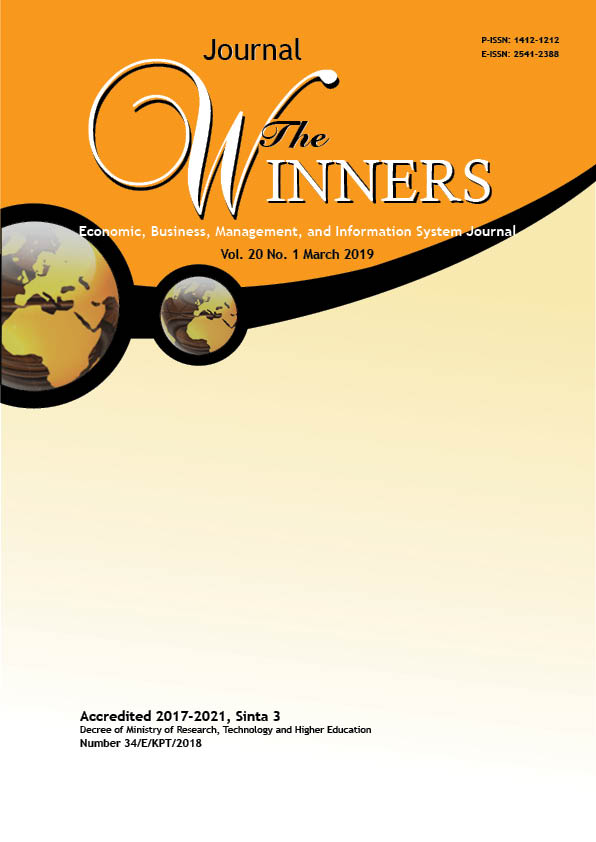Intellectual Capital Effect, Financial Performance, and Firm Value: An Empirical Evidence from Real Estate Firm, in Indonesia
DOI:
https://doi.org/10.21512/tw.v20i1.5500Keywords:
Intellectual Capital, VAIC, financial performance, firm’s valueAbstract
This research aimed to analyze the impact of intellectual capital towards the firm’s financial performance and firm’s value. Intellectual capital was measured by Value Added Intellectual Capital (VAIC) which has three components, such as Value Added Capital Employed (VACA), Value Added Human Capital (VAHU), and Structural Capital Value Added (STVA). Firm’s financial performance and firm’s value were measured by Return on Assets (ROA), Return on Equity (ROE), Revenue Growth (RG), and Tobin’s Q ratio. There were 102 observations of Property and Real Estate company sector listed in Indonesia Stock Exchange period 2014-2016 that was analyzed using the linear regression method. The results show that VAIC has a significant impact towards financial performance and firm’s value, except revenue growth, which means that the firm’s ability to generate value added and also profit with total assets and equity increase if IC is managed properly. Therefore, VACA is the only component of VAIC that has a significant impact towards financial performance and firm’s value, except RG which means that the capital employed is already managed properly.
References
Abdullah, D., & Sofian, S. (2012). The relationship between intellectual capital and corporate performance. The 2012 International Conference on Asia Pacific Business Innovation & Technology Management, 40, 537-541.
Calista, Y. (2014). Analisis perbandingan pengaruh intellectual capital terhadap kinerja keuangan dan nilai pasar perusahaan di Singapura dan Indonesia. Undergraduate Thesis. Jakarta: Universitas Bina Nusantara.
Chen, M. C., Cheng, S. J., & Hwang, Y. (2005). An empirical investigation of the relationship between intellectual capital and firms’ market value and financial performance. Journal of Intellectual
Capital, 6(2), 159-176. https://doi.org/10.1108/14691930510592771.
Edvinsson, L., & Malone, M. S. (1997). Intellectual Capital. London: Piatkus.
Fajarini, I., & Firmansyah, R. (2012). Pengaruh intellectual capital terhadap kinerja keuangan perusahaan (Studi empiris perusahaan LQ 45). Jurnal Dinamika Akuntansi, 4(1), 1-12.
Firer, S., & Williams, S. M. (2003). Intellectual capital and traditional measures of corporate performance. Journal of Intellectual Capital, 4(3), 348-360. https://doi.org/10.1108/14691930310487806.
Ghozali, I. (2013). Aplikasi analisis multivariate dengan program IBM SPSS 21. Semarang: Badan Penerbit Universitas Diponegoro.
Hashim, M., Osman, I., & Alhabshi, S. (2015). Effect of intellectual capital on organizational performance. 2nd Global Conference on Business and Social Science-2015, 211, 207-214. Retrieved from https://www.sciencedirect.com/science/article/pii/S1877042815054257.
Herdyanto, I., & Nasir, M. (2013). Pengaruh intellectual capital pada financial performance perusahaan. Diponegoro Journal of Accounting, 2(3), 1-10.
Khan, M. W. (2014). Identifying the components and importance of intellectual capital in knowledgeintensive organizations. Business and Economic Research, 4(2), 297-307.
Prabowo, D. (2017). Masyarakat mulai memilih investasi properti secara teliti. Retrieved on November 12th, 2017 from http://properti.kompas.com/read/2017/09/11/193614221/masyarakat-mulaimemilih-investasi-properti-secara-teliti.
Puspita, A. (2016). Pentingkah pengungkapan intellectual capital dalam meningkatkan nilai perusahaan. Seminar Nasional dan The 3rd Call for Syariah Paper. Surakarta, Indonesia. pp. 205-210.
Putri, A., & Purwanto, A. (2013). Pengaruh intellectual capital terhadap kinerja perusahaan perbankan yang terdaftar di Bursa Efek Indonesia (BEI) tahun 2009-2011. Diponegoro Journal of Accounting, 2(3), 1-12.
Rinaldi, M. (2017). Konsumen minati properti berkonsep unik. Retrieved on November 12th, 2017 from http://bisnis.liputan6.com/read/2858739/konsumen-minati-properti-berkonsep-unik.
Sudibya, D., & Restuti, M. (2014). Pengaruh modal intelektual terhadap nilai perusahaan dengan kinerja keuangan sebagai variabel intevrening. Benefit Jurnal Manajemen dan Bisnis, 18(1), 14-29.
Sunarsih, N. M., & Mendra, N. P. Y. (2012). Pengaruh modal intelektual terhadap nilai perusahaan dengan kinerja keuangan sebagai variabel intervening pada perusahaan yang terdaftar di Bursa Efek Indonesia. Simposium Nasional Akuntansi XV. Banjarmasin, Indonesia. pp. 1-27.
Thaib, F. (2013). Value added intellectual capital (VAHU, VACA, STVA) pengaruhnya terhadap kinerja keuangan bank pemerintah periode 2007 - 2011. Jurnal EMBA, 1(3), 151-159.
Ulum, I., Ghozali, I., & Chariri, A. (2008). Intellectual capital dan kinerja keuangan perusahaan; Suatu analisis dengan pendekatan Partial Least Squares (PLS). In Simposium Nasional Akuntansi 11
(SNA 11). Universitas Tanjung Pura Pontianak. pp. 1-31.
Ventura, B. (2017, Oktober 18). 38 peraih penghargaan Properti Indonesia Award 2017. Retrieved on November 12th, 2017 from https://ekbis.sindonews.com/read/1249286/179/38-peraihpenghargaan-properti-indonesia-award-2017-1508260909.
Volkov, D. L., & Garanina, T. A. (2007). Intangible assets: Importance in the knowledge-based economy and the role in value creation of a company. The Electronic Journal of Knowledge Management, 5(4), 539-550.
Widyaningdyah, A. (2013). Intellectual capital dan keunggulan kompetitif (Studi empiris perusahaan manufaktur versi Jakarta Stock Industrial Classification JASICA). Jurnal Akuntansi dan Keuangan, 15(1), 1-14.
Downloads
Published
How to Cite
Issue
Section
License
Authors who publish with this journal agree to the following terms:
a. Authors retain copyright and grant the journal right of first publication with the work simultaneously licensed under a Creative Commons Attribution License - Share Alike that allows others to share the work with an acknowledgment of the work's authorship and initial publication in this journal.
b. Authors are able to enter into separate, additional contractual arrangements for the non-exclusive distribution of the journal's published version of the work (e.g., post it to an institutional repository or publish it in a book), with an acknowledgment of its initial publication in this journal.
c. Authors are permitted and encouraged to post their work online (e.g., in institutional repositories or on their website) prior to and during the submission process, as it can lead to productive exchanges, as well as earlier and greater citation of published work.
USER RIGHTS
All articles published Open Access will be immediately and permanently free for everyone to read and download. We are continuously working with our author communities to select the best choice of license options, currently being defined for this journal as follows: Creative Commons Attribution-Share Alike (CC BY-SA)

















